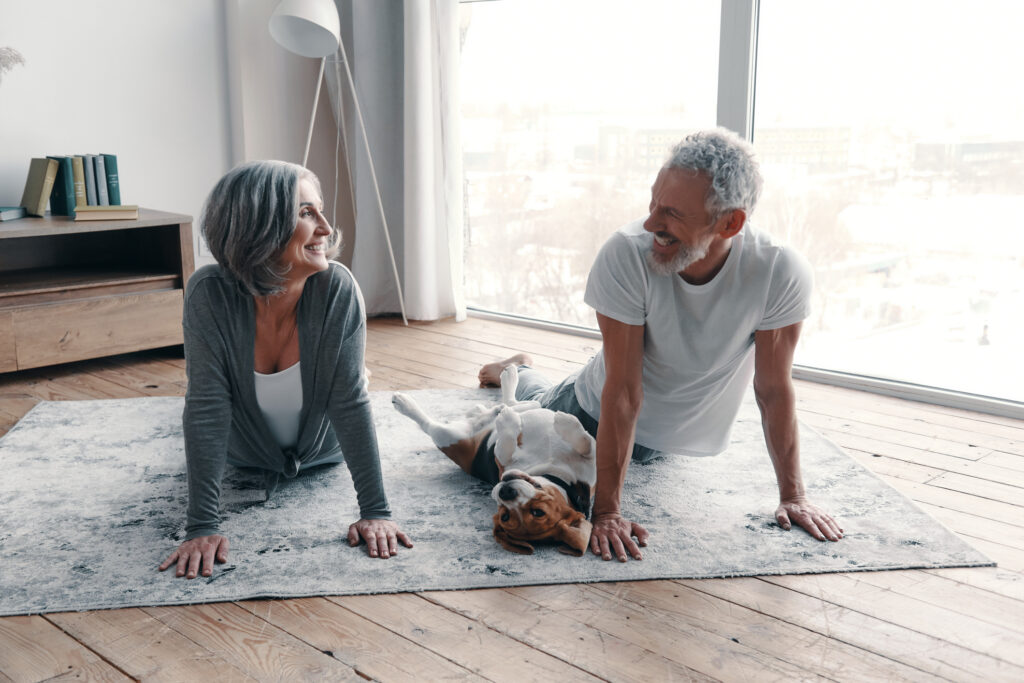
As we grow older, maintaining flexibility and joint mobility becomes key to preserving independence and enjoying daily life. Regular, gentle stretching helps keep muscles loose, reduces stiffness, improves range of motion, and may reduce the risk of falls or muscle strains. It can ease daily tasks like reaching, bending, stepping out, and getting in and out of a chair with greater ease. Stay tuned for a few ideas to help you think about your stretching routine.
Important Precautions Before You Begin
- Consult a qualified professional. This is not a personalized stretching program—think of it like general financial advice versus a custom plan from an advisor. A physical therapist or qualified instructor can design a routine that fits your medical history, fitness level, and goals.
- Start gently. Don’t push into pain. Mild discomfort as you stretch stiff muscles is normal—but sharp pain, pinching, or joint pain is a warning sign to stop.
- Warm up a bit first. A short walk or a few minutes of gentle movement helps prevent injury.
- Breathe and hold. Breathe normally while holding each stretch for around 20–30 seconds (or as the professional advises), avoiding bouncing or jerking.
- Balance bilateral stretches. Stretch both sides evenly to maintain symmetry.
Sample Ideas to Get Started
Here are a few simple stretches for those “not‑so‑flexible” individuals of all ages, modified here only as general inspiration, not a full plan.
- Neck stretches – Tilt your head slowly toward each shoulder, then forward and back. Hold gently to relieve neck tension.
- Shoulder rolls or cross‑arm stretches – Loosen tight shoulders by rolling them or crossing one arm across your chest and hugging it gently.
- Chest opener at a wall or doorway – Stand up, place your arm against a wall or doorframe, and gently rotate your torso away to open the chest.
- Seated hamstring stretch – Sit tall on a stable chair, extend one leg forward with heel on floor, and gently fold forward keeping your spine straight.
- Quadriceps stretch with chair support – Holding onto a sturdy chair or countertop, bend one knee behind, gently pulling your foot toward your buttock.
- Calf stretch with hands against wall – Step back with one leg and lean forward, keeping your heel down to stretch the lower leg.
- Triceps and upper arm stretch – Lift one arm overhead, bend elbow, and use the opposite hand to gently push elbow backward.
Each of these kinds of simple stretches can help improve mobility and ease stiffness associated with aging.
How to Build a Daily Routine
- Pick just a few moves you can do consistently, perhaps seated or standing, depending on your needs.
- Aim for short, daily sessions—just 5–10 minutes is plenty to start.
- Monitor your body’s response. If stiffness improves, you can gently increase duration or range (under expert guidance).
- Track your progress. Note which stretches get easier and how your movement feels over time.
A Reminder
Stretching is a cornerstone of healthy aging, helping maintain mobility, reduce stiffness, and support daily independence. But it’s not a substitute for personalized care. Before beginning any routine—especially if you have existing pain, joint issues, or health conditions—reach out to a licensed physical therapist or qualified instructor to create a tailored stretching plan that you can feel confident is designed to make you feel great in your body, just as you’d consult a trusted advisor for a tailored financial plan. Click HERE to reach out to one of our professionals at Zinnia Wealth Management today for a complimentary review of your finances.






